|
June 8, 2012 - No. 86
The Need for the Working Class to
Constitute Itself the Nation
Dogfight Over the Detroit River
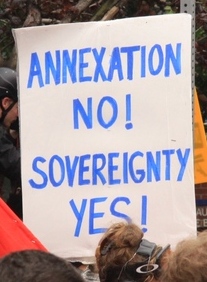 
The
Need
for
the
Working
Class
to Constitute Itself the Nation
• Dogfight Over the Detroit River
• Financial Oligarchs and Their Representatives
Gather for Bilderberg Group Summit - Dougal MacDonald
Canada's
Annexation
into United States of North American Monopolies
• Integrated Security Apparatus for Cargo
Shipments - Charlie Vita
• Canada Joins U.S. Space Surveillance Network
• RCMP Being Trained in U.S.
• New Unified Command for Canadian Forces
The Need for the Working Class to
Constitute Itself the Nation
Dogfight Over the Detroit River
An ugly fight is underway over the building of a new
bridge between
Windsor and Detroit. U.S. billionaire private owner of the existing
Ambassador Bridge, Matty Moroun, is spending millions to stop any new
competing bridge from being built. He apparently has political support
in the Michigan State Legislature
and is funding a petition calling for a November referendum to stop the
proposed project.
The most avid proponents of a new bridge are the Harper
government,
Ontario Premier McGuinty and Michigan Governor Rick Snyder. They have
cooked up a secret public-private-partnership deal where the Canadian
public treasury will eventually pay the entire cost of $1.5 billion, a
private company will be
contracted to manage and maintain the bridge when built, and private
construction and material supply monopolies will profit handsomely.
A bewildering aspect arises from the antics of U.S. and
Michigan
political executives of the self-described richest country in the world
who are crying poverty and saying their treasuries are so broke that if
the bridge is to be built at all then the Canadian public treasury will
have to shoulder the entire burden
of approximately $1.5 billion. Prime Minister Harper with the
quiet approval of Premier McGuinty has apparently agreed to this
outrageous demand!
 Harper never tires of
demanding austerity from Canadians and
attacking the working class. Most recently, he fired almost 20,000
federal public service workers, wrecking or privatizing the services
they provide. He also passed legislation outlawing the just struggles
of CPR, Air Canada and Canada Post workers
for new collective agreements. Harper never tires of
demanding austerity from Canadians and
attacking the working class. Most recently, he fired almost 20,000
federal public service workers, wrecking or privatizing the services
they provide. He also passed legislation outlawing the just struggles
of CPR, Air Canada and Canada Post workers
for new collective agreements.
But austerity does not extend to pay-the-rich and other
schemes such
as the bridge across the Detroit River. No, austerity has been thrown
to the wind in Harper's role as puppet leader of an annexed Canada
eager to hand over hundreds of millions of dollars to the U.S. Empire
for what should be a joint public
project. Harper says Canada's money will be returned eventually,
however, not from the U.S. or Michigan treasuries but from user fee
tolls to cross the bridge. Canadians are to be skinned more than twice:
first by paying the private construction and material supply monopolies
for the entire joint project plus any
interest to finance capitalists who may lend money to the government;
secondly by paying user fee bridge tolls for decades to come and,
again, with austerity measures as the government declares it has to
eliminate deficits and bring down debt. Quite remarkable largesse for
Harper and McGuinty who never tire of
telling Canadians that the country and province are approaching dire
straights because they are saddled with deficits and debts to the
financial oligarchy and cannot afford social programs or public
services and constantly demand concessions from workers.
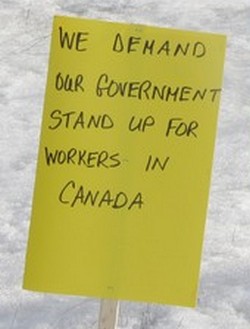 The nonsense does not end
with Canadian public money paying for the
U.S. portion of the joint project. Michigan Governor Snyder is planning
an executive end run around the Ambassador Bridge owner Matty Maroun's
opposition and his allies in the State Legislature. Snyder is
organizing a secret "interlocal"
agreement reportedly involving Michigan, the White House, Harper and
McGuinty. The deal would bypass the opposition in the Michigan
Legislature and be finalized before any possible November referendum.
This is another example of rule by executive decree and as well reveals
what happens when anarchy prevails
and different private interests vie for control of public authority to
advance their interests. The nonsense does not end
with Canadian public money paying for the
U.S. portion of the joint project. Michigan Governor Snyder is planning
an executive end run around the Ambassador Bridge owner Matty Maroun's
opposition and his allies in the State Legislature. Snyder is
organizing a secret "interlocal"
agreement reportedly involving Michigan, the White House, Harper and
McGuinty. The deal would bypass the opposition in the Michigan
Legislature and be finalized before any possible November referendum.
This is another example of rule by executive decree and as well reveals
what happens when anarchy prevails
and different private interests vie for control of public authority to
advance their interests.
But a snag has leaked out regarding procurement of the
steel and
other material, which of course in any large project is a source of
enormous private profit and fierce competition. Wrangling has erupted
over what procurement rules should apply especially for the structural
steel. A rumour is circulating that Harper
and possibly McGuinty want to use cheaper Chinese steel. This has sent
the Obama "Buy America" factional interests into a rage even though
they are not paying a penny for the bridge. The "Buy America" activists
say that the interlocal agreement and executive approval of the bridge
is tied to $2.2 billion in U.S.
federal money for road and other infrastructure improvements in
Michigan, which according to them means that the new bridge must come
under the "Buy America" procurement rules regardless of Canadian public
money paying its entirety.
Canada's consul general in Detroit, Roy B. Norton, is
quoted in
local media as saying, "The supposed issue over using Chinese steel to
build a new bridge to Windsor is a fiction, a poorly informed report. I
don't know who the source of the report was.... They clearly aren't
informed about Canadian government
procurement policy."
Most Canadians would say they are also "not informed
about Canadian
government procurement policy" because for the Harper government
everything is based on secrecy and private interests, certainly not
openness, public discussion and input to serve and politicize the
public interest.
TML would like the Canadian consul general or
somebody in
the Harper or McGuinty governments to inform Canadians as to where the
steel is going to come from if it is not Chinese steel. Is it going to
come from a U.S.-based steel plant? We know it will not come from
Hamilton Works because
U.S. Steel refuses to restart its blast furnace. Besides, during the
wrecking of the Canadian manufacturing and steel industries over the
last dozen years, the making of Canadian structural steel has been a
victim. Stelco cratered its capacity before and during its phony
bankruptcy.
Canadians are financing the bridge project with the
people's money;
should the steel and other material not come from Canada, at least half
of it? The U.S. can use whatever steel it wants, we suppose, since it
has so generously agreed to accept Canadian public money to pay for its
half of the bridge.
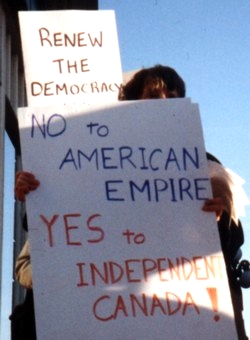 Some sources in Canada are now
saying that in this situation "Buy
America" is fine if it is broadened and becomes a "Buy North America"
annexed version. Apparently some in the Obama camp will accept that
proposal under certain conditions: "Buy North America" is fine, they
say, when applied to Canada
but not the U.S.; it is especially fine for Canada if it does not have
the capacity to supply what is needed such as structural steel because
the industry has been wrecked and taken over by global monopolies that
refuse to increase and invest in local production meaning the
structural steel will be supplied from North
America, in this case the U.S. and not from China or elsewhere. But to
be perfectly clear, within the U.S. only "Buy America" is acceptable. Some sources in Canada are now
saying that in this situation "Buy
America" is fine if it is broadened and becomes a "Buy North America"
annexed version. Apparently some in the Obama camp will accept that
proposal under certain conditions: "Buy North America" is fine, they
say, when applied to Canada
but not the U.S.; it is especially fine for Canada if it does not have
the capacity to supply what is needed such as structural steel because
the industry has been wrecked and taken over by global monopolies that
refuse to increase and invest in local production meaning the
structural steel will be supplied from North
America, in this case the U.S. and not from China or elsewhere. But to
be perfectly clear, within the U.S. only "Buy America" is acceptable.
This stand does not favour either Canadian or American
workers or
their societies since the entire thing is a dogfight over who gets to
benefit from the pay-the-rich schemes. The danger of this stand is that
it seeks to line the working class up of both Canada and the United
States behind the U.S. in its inter-imperialist
and inter-monopoly contention with its rivals.
In opposition to this imperialist dictate, Information
Update,
newsletter of Local 1005 USW, made a suggestion for the Canadian
government: "Instead of handing over $550 million to Michigan for the
bridge, tell them to use part of the $2 billion in U.S. federal money
to finance their portion of the bridge. Then Canada can use the $550
million as seed money to build our own Canadian structural steelmaking
public enterprise, and in addition, demand U.S. Steel reopen our
Hamilton blast furnace so that Canadian steel and construction workers
can build our half of the new bridge." (Information Update, June 7)

Financial Oligarchs and Their Representatives
Gather for Bilderberg Group Summit
- Dougal MacDonald -
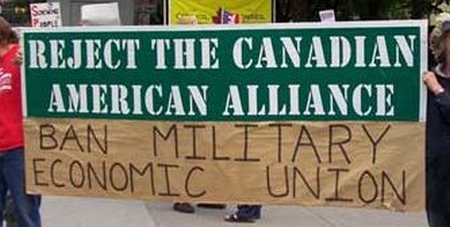 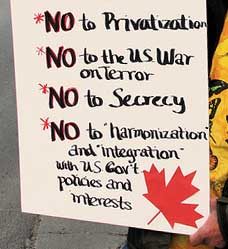
From May 31 to June 3, Alberta Premier Alison Redford
met in secret with top members of the world financial oligarchy at the
annual Bilderberg Group summit held this year in Chantilly, Virginia.
The 120-140 attendees are mainly from the U.S. and Western Europe.[1] Attendance is only by
invitation; two other
Alberta premiers have been invited in past years: Peter
Lougheed (1973) and Ralph Klein (1995). No other Canadian premiers were
invited this year, however, Prime Minister Stephen Harper's Chief of
Staff Nigel Wright attended along with Mark Carney, Governor of the
Bank of Canada.
Noteworthy this year at
Bilderberg was the large number of politicians and government officials
that participated, for example, Mitch Daniels, governor of Indiana, the
first "Rust Belt" right-to-work state. Also invited was Bassma Kodmani,
Member of the Executive Bureau and Head of Foreign Affairs of the
so-called rebel Syrian National Council. This suggests discussions were
held regarding the imperialists' future war plans against Syria.
Overall, it seems logical to assume that politicians in attendance were
there to receive their updated marching orders from their masters, who
represent some of the largest monopolies
in the world (e.g., Alcoa, Dow, Siemens, Deutsche Bank, Barclays, Shell
Oil, Michelin, TD Bank.
The annual Bilderberg Group was initiated in 1954 by
German Prince Bernhard of Lieppe-Biesterfield (born 1911 in Jena,
central Germany), a member of Hitler's Nazi Party and Himmler's S.S.
The aim was to build tighter alliances between U.S. and Western
European monopolies as part of waging the Cold
War against the Soviet Union and communism. Walter Bedell Smith, head
of the CIA, and Joseph Retzinger, an anti-communist Polish politician,
assisted Prince Bernhard who became Bilderberg chairman in 1959 until
1975.
Prior to this, in 1935, Bernhard became Secretary to the
Board of
Directors of Farben Bilder in Paris from which he took the name of the
conference. Farben Bilder's parent company, I.G. Farben, was vital to
the Nazi war machine and produced the Zyklon B gas that the German
authorities used to execute millions of
prisoners. In 1937, Bernhard married Queen Juliana of the Netherlands
and became her prince consort, a very cushy position indeed with
influence and connections in both Nazi Germany and among the Western
allies.[2] After the
Second World
War, Bernhard was
made a director of KLM Airlines, which was accused of
helping transfer Nazi war criminals to Argentina. In 1975, Bernhard
resigned his Bilderberg chairmanship under a cloud, having accepted a
$1.1 million bribe from Lockheed Corporation to influence the Dutch
government's purchase of fighter aircraft. Another Bernhard scandal
emerged in 1995 when it was revealed
that mercenaries he had hired, supposedly to help the World Wildlife
Fund -- which he founded in 1961 -- stop wildlife poachers, were
actually
planning assassinations of South African resistance fighters in battle
against the apartheid regime.
No mystery surrounds why Premier Redford and other
Alberta premiers have received invitations to the Bilderberg Group
Summit to
hob nob with many of the richest and most influential leaders of the
imperialist world. Alberta has huge reserves of petroleum, the world's
most important strategic product, which is essential
to the functioning of the U.S. war machine and its industries. U.S.
imperialist leaders were major participants in Bilderberg 2012. For
example, one attendee was White House National Security Advisor Thomas
Donilon.
There is also no mystery as to the position the Redford
government always takes regarding the financial oligarchy's ease of
access to Alberta's energy resources. The May 24 Throne
Speech of the Redford government states more emphatically than ever
that Alberta's doors are wide open to
the monopolies:
"This province is the most economically free
jurisdiction in North America. Nowhere else do businesses have so much
room to operate without interference and adapt to market conditions.
Your government will further these freedoms and find new ways to
simplify regulatory burdens."
Spokespersons for Bilderberg claim that only "informal"
discussion takes place at the annual summits and that no decisions are
made or acted upon as a result. However, insiders suggest that when
Bilderberg participants reach a consensus about what is to be done,
they have at their disposal powerful international
and national instruments for achieving their goals. For example, the
Bilderberg Group meeting in May 2009 was attended by the Greek Minister
of Finance, the Governor of the National Bank of Greece, the Greek
Minister of Foreign Affairs, various Greek capitalists, and three
former heads of the World Bank. It
seems more than a coincidence that following the meeting the Eurozone
countries and the IMF agreed to a $110 billion bailout of the Greece
economy, with most of the money to be transferred to the international
lenders and holders of Greek debt. The bailout demanded massive attacks
on social programs, public
services and the Greek standard of living and a commitment to continue
to use Greek social product to pay international lenders. Such
consensus of the financial oligarchs, amongst whom so many
contradictions exist, suggests a leading group such as the Bilderberg
Group wields enormous influence backed
up by a big stick.
The Bilderbergers may also meet outside the annual
summit to achieve an immediate aim. On November 12, 2009, the group
hosted a dinner meeting at Brussels' Château de Val-Duchesse to
promote former Belgian Prime Minister Herman
Van Rompuy as their chosen candidate for President of the European
Council.
One week later, Van Rompuy was unanimously voted president.
Notes
1. An official list of 2012
participants is here:
http://www.infowars.com/bilderberg-2012-the-official-list-of-participants/
2. An ongoing mystery is why declassified
U.S. State Department documents show that Juliana and other members of
the Dutch Royal Family were at Chatham, Cape Cod on August 26, 1944, at
the same time that a large German Type XI-B U-Boat was said to be
operating in the area. Possibly the Dutch aristocrats
were to be intermediaries for German-U.S. negotiations dealing with how
to end the war in Europe and block the people from overthrowing
imperialism and opting for communism.

Canada's Annexation into United States of
North American Monopolies
Integrated Security Apparatus for Cargo Shipments
- Charlie Vita -
 On May 31, the Harper
government announced that it was activating a
North American system of air cargo security as part of a plan to extend
this system to all forms of cargo shipment on land, sea and air. The
arrangement places Canadian territory further under the control of U.S.
Homeland Security. It means
that goods that come into Canada from the United States will not be
screened by Canadian security officials, only U.S. Homeland Security.
To establish the set-up, U.S. officials were reportedly given full
access to Canada's "national security program." The media provide
little if any information about these arrangements.
There are no media reports to indicate whether they are reciprocal and
it is Canadian security officials who secure the goods going into the
United States from Canada or U.S. Homeland Security operating on
Canadian territory or whether there is now only one agency called U.S.
Homeland Security into which Canadian
security officials are integrated. On May 31, the Harper
government announced that it was activating a
North American system of air cargo security as part of a plan to extend
this system to all forms of cargo shipment on land, sea and air. The
arrangement places Canadian territory further under the control of U.S.
Homeland Security. It means
that goods that come into Canada from the United States will not be
screened by Canadian security officials, only U.S. Homeland Security.
To establish the set-up, U.S. officials were reportedly given full
access to Canada's "national security program." The media provide
little if any information about these arrangements.
There are no media reports to indicate whether they are reciprocal and
it is Canadian security officials who secure the goods going into the
United States from Canada or U.S. Homeland Security operating on
Canadian territory or whether there is now only one agency called U.S.
Homeland Security into which Canadian
security officials are integrated.
The Harper government invokes "national security" to
control all
aspects of Canadians' private lives, but when it comes to Canada's
national and international transportation system on which everyone
relies, it can place it in the hands of U.S. Homeland Security! This is
the same U.S. which has been implicated
in all sorts of black ops and support for terrorist activities -- the
same U.S. which has protected terrorist Luis Posada Carrilles who
admitted to blowing up a Cubana airliner in 1976 killing all its
passengers!
Meanwhile, Canadians are told that they cannot know what
the
government is up to in its dealings with the U.S. because of "national
security reasons." Clearly what is good for the U.S. is not good for
Canadians.
The Harper government informs that since signing the
Security
Perimeter Agreement in December 2011, Canadian and U.S. officials have
been working "to ensure commensurate security controls exist within
their air cargo security programs." Within this process each country
"formally reviewed the other's national
security program including: program design, regulations, oversight and
compliance, audit and site validation visits." As a result of this
process, Canada and the U.S. "achieved mutual recognition of their
respective national air cargo security programs effective March 31st,
2012."
Under the new "mutual recognition initiative," cargo
shipped on
passenger aircraft will now be screened only once, at the point of
origin and will not be rescreened prior to upload on an aircraft in the
other country.
According to the government, the following example
illustrates how the system will work:
"[A] shipment of Canadian computer games purchased by a
U.S. company
would have had to comply with the rules of both air cargo programs and
be re-screened resulting in extra paperwork and additional screening
cost for the shipper. Today, that same shipment doesn't have to be
screened once it gets to the
U.S. before being loaded on passenger aircraft meaning fewer security
delays. With the two countries mutually recognizing each other's air
cargo security programs, the efficiency of screening is improved and
the burden on the industry is reduced."
Furthermore, the government states, "There is a large
variation in
the physical size and configuration of cargo, the nature of wrapping
and crating used, and material contents differ widely. For example, the
technology used to screen a suitcase does not work for a large pallet
of machine parts.
"To accommodate these differences, air cargo in Canada
is screened
using several methods including physical inspection, canine check,
explosive trace detection or x-ray scanning. The details of these
requirements and how they are applied are confidential, for security
reasons."
The Canadian government's intention is to apply this
standard to all
forms of cargo shipment in the future. "Air cargo is just the start.
Canada and the U.S. are working together to strengthen co-ordination,
co-operation and timely decision-making at the border for cargo shipped
by sea or land with a view to increasing
two-way trade, and reducing travel and commercial disruptions. When the
Action Plan is fully implemented, the principle of 'screened once,
accepted twice' is intended to apply to all modes of shipping cargo," a
government news release points out.

Canada Joins U.S. Space Surveillance Network
On May 23, just two days after the Chicago NATO
Summit where NATO leaders announced new measures to integrate
surveillance technologies as part of NATO's war preparations, Canada's
Department of National Defence (DND) announced that a
long-term partnership with the U.S. Department
of Defense on Space Situational Awareness (SSA) had been established.
DND informs that Canada's Vice-Chief of Defence
Staff Vice-Admiral Bruce Donaldson,[1]
and Heidi Grant, Deputy Under Secretary of the U.S. Air Force
(International Affairs) signed the SSA Memorandum of Understanding on
May 4. Under the agreement, data from DND's soon to be launched
Sapphire
satellite will be integrated with the U.S. Space Surveillance Network.
According to DND the agreement is aimed at "enhancing the ability of
both
countries to detect and avoid the collision of critical space platforms
with orbital debris." The Sapphire satellite is a "space-based
electro-optical sensor" that will track "natural
and man-made space debris in high earth orbit." It is scheduled for
launch later this year.
"As reliance on space and satellite capabilities
increases, so too does the need to know what is happening in space, and
to act on that knowledge," said Vice-Admiral Donaldson following the
announcement.
Despite claims that the aim of the integration is to
"avoid collisions between satellites or with space debris," this
development follows similar arrangements in which Canada is being
integrated into U.S. arrangements to militarize space. For example, in
November 2011 it was announced that Canada was spending
$477 million to join a U.S. Defense Department satellite communication
system called the Wideband Global Satellite (WGS) System. The system is
designed for "U.S. warfighters, allies and coalition partners during
all levels of conflict, short of nuclear war."
Note
1. Donaldson was the former
head of Canada Command who oversaw operations at the G20 Summit in
Toronto and Vancouver Olympics, and who co-authored the annexationist
NORAD report: Framework for Enhanced
Military Cooperation among North American Aerospace Defense Command,
United States Northern Command,
and Canada Command. The report laid out the new arrangements
demanded so as to place Canada Command "seamlessly" under the control
of U.S. Northern Command.

RCMP Being Trained in U.S.
Reports reveal that RCMP agents are currently being
trained by U.S.
Security Agents in the United States as part of the Shiprider
arrangement. This arrangement will be made permanent if the Harper
government's Omnibus Budget Bill C-38, An Act to Implement Certain
Provisions of the Budget Tabled
in Parliament on March 29, 2012 and Other Measures, passes.
The Shiprider arrangement has Canadian and U.S.
"cross-border
officers" operating as an Integrated Border Enforcement Team (IBET) in
either country. Currently the arrangement is being used to police joint
waterways; however plans are in place to extend this to include land
and air policing.
According to Embassy Magazine, IBET training
takes place at
the U.S. Federal Law Enforcement Training Center in Charleston, South
Carolina. Since 2005, roughly 140 Canadian and U.S. cross-border
officers have been trained. The increased number of officers
being trained this year, 84,
indicates increased emphasis on such joint programs. Each RCMP officer
trained costs the RCMP around $75,000 to cover travel and
accommodation -- costs for the courses are paid for by the
U.S. Overall, if one assumes half of this year's trainees are RCMP
officers (42), this amounts to a cost
of more than $3 million.
In addition to the specific U.S. training for Shiprider,
vessels
are being built specifically for the Shiprider teams. This
goes against the notion presented by the Harper government of U.S. or
Canadian officers operating on one another's vessels, which itself is
bad enough. It is clear that a new policing
institution is being established with its own infrastructure and
training in the U.S.
It is likely that one of the aims of entrenching the
Shiprider
agreement into law is so that more resources can be allocated to fund
training and the building of infrastructure. RCMP officials have
alluded to the fact that thus far large security events have been used
to fund the program. "Even in the absence of dedicated
resources, there will be things like the Olympics, like the G20," one
RCMP official stated. This raises the likelihood that a portion of the
over $1 billion spent on policing the G8 and G20 in 2010 went to
finance the Shiprider arrangement. Much of the money used for the G8
and G20 was reportedly drawn from
a Border Security Fund.
The report also notes that U.S. security agents have
been placed at
the Marine Security Operation Centre in the Niagara Region. The Centre
is where the centralization of Canadian marine police forces
responsible for the Great Lakes
and St. Lawrence Seaway (RCMP,
Canadian Border Services Agency, Coast Guard, Canadian Military) is
taking place.

New Unified Command for Canadian Forces
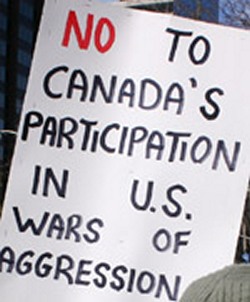 On May 11, Defence Minister Peter MacKay
announced that
the Harper government was centralizing the command and control of the
Canadian Armed Forces. The announcement was presented as a measure to
streamline cost in an era of fiscal restraint. MacKay announced that
the Canadian Forces (CF) will
launch a revised Operational Command and Control structure, creating a
single command, the Canadian Joint Operations Command (CJOC). The
creation of a single command structure for the CF will bring under it
the activities of Canada Command [responsible for operations in North
America], Canadian Expeditionary
Force Command [responsible for interventions abroad], and Canadian
Operational Support Command [responsible for logistics, military
engineering, health services and military police etc.]. According to
MacKay the new headquarters will be responsible for "conducting all CF
operations in Canada, North America,
and globally, in concert with national and international partners." On May 11, Defence Minister Peter MacKay
announced that
the Harper government was centralizing the command and control of the
Canadian Armed Forces. The announcement was presented as a measure to
streamline cost in an era of fiscal restraint. MacKay announced that
the Canadian Forces (CF) will
launch a revised Operational Command and Control structure, creating a
single command, the Canadian Joint Operations Command (CJOC). The
creation of a single command structure for the CF will bring under it
the activities of Canada Command [responsible for operations in North
America], Canadian Expeditionary
Force Command [responsible for interventions abroad], and Canadian
Operational Support Command [responsible for logistics, military
engineering, health services and military police etc.]. According to
MacKay the new headquarters will be responsible for "conducting all CF
operations in Canada, North America,
and globally, in concert with national and international partners."
The change brings Canada into line with
annexationist recommendations made in the Framework for Enhanced Military
Cooperation among North American Aerospace Defense Command, United
States Northern Command, and Canada Command. That document was
released jointly by the heads of U.S. Northern Command
and Canada Command with the aim of establishing joint military
operations in North America under NORAD Command--meaning U.S. Northern
Command. (See TML Weekly No. 8, February 25, 2012.)
In
the
report
the
necessity
to
bring
Canada's command structures within
Canada Command in line with the centralized
U.S. Northern Command structure was clearly articulated as something to
be sorted out.
According to MacKay the changes are a result of the
experiences of the Canadian forces operating at a "high tempo" in the
recent period. This "high tempo" includes: the invasion of Afghanistan,
militarization of aid to post-earthquake Haiti, invasion of Libya,
the G20 in Toronto and the Vancouver Olympics. The changes
are also the result of recommendations from the 2011 Transformation
report prepared by Lieutenant-General Andrew Leslie. Leslie's
recommendations were focused on increasing the Canadian Forces' ability
to wage aggressive war abroad and militarize civilian life at home.
Leslie summarized the aims of his recommendations
in this way: "...we are going to have to reduce the tail of today while
investing in the teeth of tomorrow."
The newly established structure will be implemented in a
phased approach in the upcoming months, and will be commanded by a
Lieutenant-General. The first phase will result in a 25 per cent
reduction in national-level command and control "overhead," and it will
make more efficient use of administrative
resources.
The transformations also include changes to the Royal
Canadian Navy as it prepares to operate the new fleet commissioned by
the Federal Government. The changes include:
- The creation of the Directorate Canadian Submarine
Force (DCSF);
- The consolidation of the five naval schools under one
single training authority;
- Coastal Personnel Coordination Centres (PCC) will be
brought under a single authority;
- The creation of a single fleet scheduling management
authority;
- Formalizing the role of a national Maritime Component
Commander (MCC) for international deployments; and
- The creation of the Directorate New Capability
Introduction (DNCI).
Speaking to the changes, Canada's Chief of Defence Staff
Walter Natynczyk stated: "I'm committed to protecting Canada and
Canada's interests in the world, working with our global and
continental allies, along with our federal, provincial and regional
partners here at home. The implementation of the CJOC
will result in a smaller, more efficient organization that will
continue to deliver the same excellence in operational support to all
of our people, at home and abroad. Furthermore, one command and control
system will help us to deliver the capabilities required to face
current conflicts and better plan for future global
security challenges."

Read The Marxist-Leninist
Daily
Website: www.cpcml.ca
Email: editor@cpcml.ca
|



 Harper never tires of
demanding austerity from Canadians and
attacking the working class. Most recently, he fired almost 20,000
federal public service workers, wrecking or privatizing the services
they provide. He also passed legislation outlawing the just struggles
of CPR, Air Canada and Canada Post workers
for new collective agreements.
Harper never tires of
demanding austerity from Canadians and
attacking the working class. Most recently, he fired almost 20,000
federal public service workers, wrecking or privatizing the services
they provide. He also passed legislation outlawing the just struggles
of CPR, Air Canada and Canada Post workers
for new collective agreements. The nonsense does not end
with Canadian public money paying for the
U.S. portion of the joint project. Michigan Governor Snyder is planning
an executive end run around the Ambassador Bridge owner Matty Maroun's
opposition and his allies in the State Legislature. Snyder is
organizing a secret "interlocal"
agreement reportedly involving Michigan, the White House, Harper and
McGuinty. The deal would bypass the opposition in the Michigan
Legislature and be finalized before any possible November referendum.
This is another example of rule by executive decree and as well reveals
what happens when anarchy prevails
and different private interests vie for control of public authority to
advance their interests.
The nonsense does not end
with Canadian public money paying for the
U.S. portion of the joint project. Michigan Governor Snyder is planning
an executive end run around the Ambassador Bridge owner Matty Maroun's
opposition and his allies in the State Legislature. Snyder is
organizing a secret "interlocal"
agreement reportedly involving Michigan, the White House, Harper and
McGuinty. The deal would bypass the opposition in the Michigan
Legislature and be finalized before any possible November referendum.
This is another example of rule by executive decree and as well reveals
what happens when anarchy prevails
and different private interests vie for control of public authority to
advance their interests. Some sources in Canada are now
saying that in this situation "Buy
America" is fine if it is broadened and becomes a "Buy North America"
annexed version. Apparently some in the Obama camp will accept that
proposal under certain conditions: "Buy North America" is fine, they
say, when applied to Canada
but not the U.S.; it is especially fine for Canada if it does not have
the capacity to supply what is needed such as structural steel because
the industry has been wrecked and taken over by global monopolies that
refuse to increase and invest in local production meaning the
structural steel will be supplied from North
America, in this case the U.S. and not from China or elsewhere. But to
be perfectly clear, within the U.S. only "Buy America" is acceptable.
Some sources in Canada are now
saying that in this situation "Buy
America" is fine if it is broadened and becomes a "Buy North America"
annexed version. Apparently some in the Obama camp will accept that
proposal under certain conditions: "Buy North America" is fine, they
say, when applied to Canada
but not the U.S.; it is especially fine for Canada if it does not have
the capacity to supply what is needed such as structural steel because
the industry has been wrecked and taken over by global monopolies that
refuse to increase and invest in local production meaning the
structural steel will be supplied from North
America, in this case the U.S. and not from China or elsewhere. But to
be perfectly clear, within the U.S. only "Buy America" is acceptable.


 On May 31, the Harper
government announced that it was activating a
North American system of air cargo security as part of a plan to extend
this system to all forms of cargo shipment on land, sea and air. The
arrangement places Canadian territory further under the control of U.S.
Homeland Security. It means
that goods that come into Canada from the United States will not be
screened by Canadian security officials, only U.S. Homeland Security.
To establish the set-up, U.S. officials were reportedly given full
access to Canada's "national security program." The media provide
little if any information about these arrangements.
There are no media reports to indicate whether they are reciprocal and
it is Canadian security officials who secure the goods going into the
United States from Canada or U.S. Homeland Security operating on
Canadian territory or whether there is now only one agency called U.S.
Homeland Security into which Canadian
security officials are integrated.
On May 31, the Harper
government announced that it was activating a
North American system of air cargo security as part of a plan to extend
this system to all forms of cargo shipment on land, sea and air. The
arrangement places Canadian territory further under the control of U.S.
Homeland Security. It means
that goods that come into Canada from the United States will not be
screened by Canadian security officials, only U.S. Homeland Security.
To establish the set-up, U.S. officials were reportedly given full
access to Canada's "national security program." The media provide
little if any information about these arrangements.
There are no media reports to indicate whether they are reciprocal and
it is Canadian security officials who secure the goods going into the
United States from Canada or U.S. Homeland Security operating on
Canadian territory or whether there is now only one agency called U.S.
Homeland Security into which Canadian
security officials are integrated. On May 11, Defence Minister Peter MacKay
announced that
the Harper government was centralizing the command and control of the
Canadian Armed Forces. The announcement was presented as a measure to
streamline cost in an era of fiscal restraint. MacKay announced that
the Canadian Forces (CF) will
launch a revised Operational Command and Control structure, creating a
single command, the Canadian Joint Operations Command (CJOC). The
creation of a single command structure for the CF will bring under it
the activities of Canada Command [responsible for operations in North
America], Canadian Expeditionary
Force Command [responsible for interventions abroad], and Canadian
Operational Support Command [responsible for logistics, military
engineering, health services and military police etc.]. According to
MacKay the new headquarters will be responsible for "conducting all CF
operations in Canada, North America,
and globally, in concert with national and international partners."
On May 11, Defence Minister Peter MacKay
announced that
the Harper government was centralizing the command and control of the
Canadian Armed Forces. The announcement was presented as a measure to
streamline cost in an era of fiscal restraint. MacKay announced that
the Canadian Forces (CF) will
launch a revised Operational Command and Control structure, creating a
single command, the Canadian Joint Operations Command (CJOC). The
creation of a single command structure for the CF will bring under it
the activities of Canada Command [responsible for operations in North
America], Canadian Expeditionary
Force Command [responsible for interventions abroad], and Canadian
Operational Support Command [responsible for logistics, military
engineering, health services and military police etc.]. According to
MacKay the new headquarters will be responsible for "conducting all CF
operations in Canada, North America,
and globally, in concert with national and international partners."